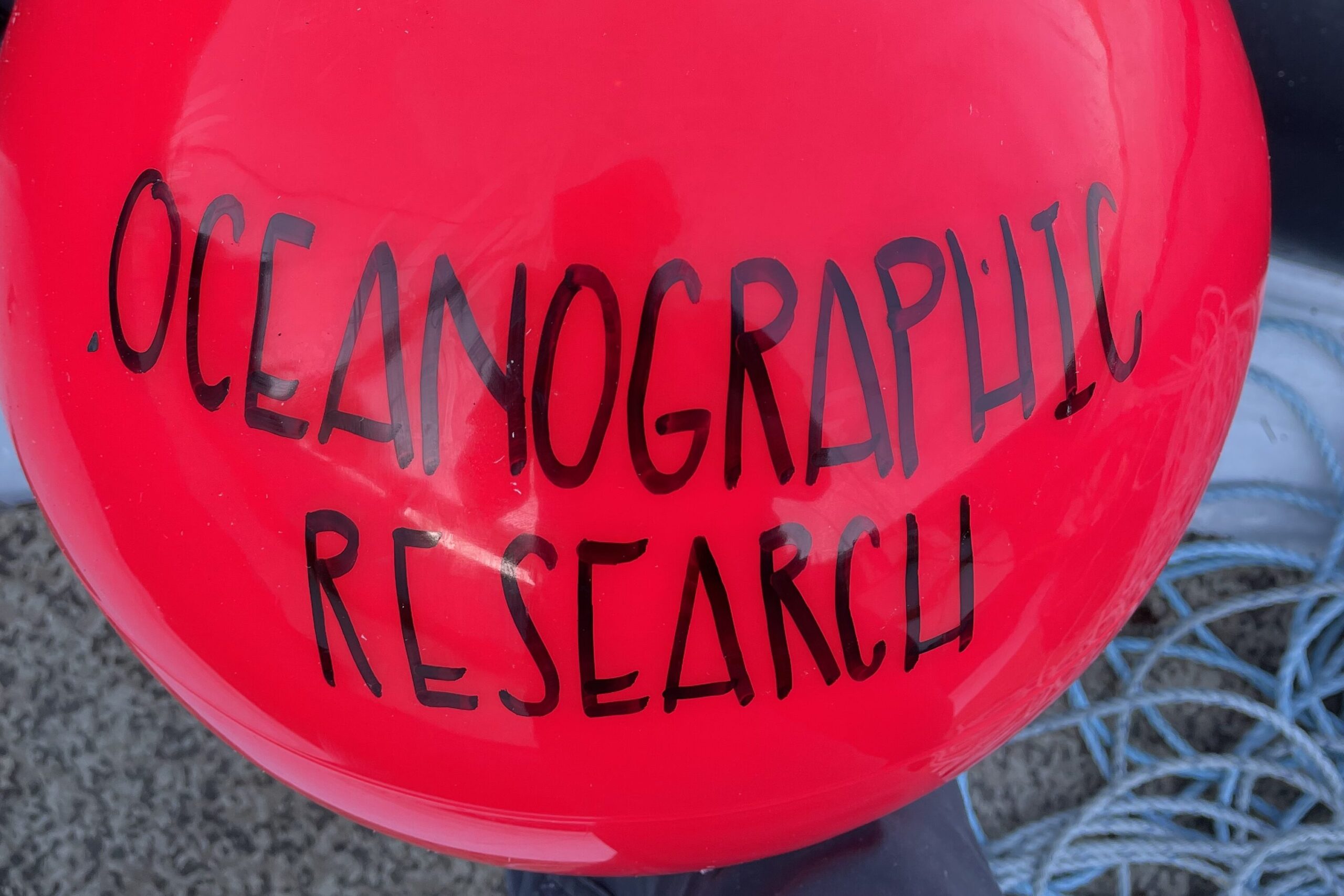This spring, the Small Ship Tour Operators Association (SSTOA), Wilderness Tourism Association of British Columbia (WTA), and Oregon State University (OSU), were awarded funding from the Climate Ready B.C. Seafood Program.
The $1.7 million fund from B.C.’s Ministry of Agriculture and Food aims to enhance our understanding of ocean acidification and hypoxia (OAH) in British Columbia and foster resilience of B.C.’s coastal food security. The SSTOA’s project is one of 11 proposals that were funded. They were chosen for their alignment with program priorities, meaningful collaborations, and high impact on understanding OAH on the BC coast.


The purpose of the project, led by our own Dr. Russ Markel, is to contribute to the understanding of geographic and seasonal variability of ocean acidification and hypoxia (low oxygen conditions) throughout nearshore regions of B.C.’s Northern Shelf Bioregion by establishing a large-scale citizen science project aimed at increasing understanding and awareness of OAH by engaging tourists in this citizen-science project itself and via onboard presentations and media.
Below we dive into how climate change impacts the oceans and causes ocean acidification and hypoxia, and describe more about this groundbreaking project.
How does climate change impact the ocean?
Increasingly, climate change has been in the news, with a particular focus on the direct threats to people – heatwaves, increased fire activity and droughts, and more intense storms and flooding. The changes in climate are due to carbon dioxide (CO2) and other heat trapping gasses, like methane, being released into the atmosphere from human activities, such as burning fossil fuels, deforestation, and industrial agriculture.
The ocean has an important role to play in the climate, helping to buffer some of the worst impacts of climate change by absorbing more than 90% of the excess heat and about 25% of CO2. But this can negatively impact our oceans and the coastal species that depend on them for food, habitat, and well being.
Trapping heat and absorbing CO2 leads to the ocean becoming warmer, more acidic, and holding less oxygen. These changes have consequences, including accelerating sea level rise in some areas, bleaching corals, loss of suitable habitat, larger and more frequent algal blooms, impacts to shell-building animals such as corals, clams, crabs and oysters, and disruptions to marine and coastal food webs and fisheries. The types and magnitude of these impacts vary across the world, with some regions and local areas being more vulnerable to change than others. This is because different areas of the oceans have different oceanographic processes, shorelines, and physical and chemical properties. To better understand this, it helps to understand how increasing heat and carbon dioxide affect seawater chemistry.
What’s happening on the BC coast?
In British Columbia and other parts of the Pacific Northwest, climate change impacts -, including marine heat waves, low oxygen levels, and ocean acidification -, are of major concern to coastal communities. Many people in this part of the world depend on the coasts and oceans for their livelihoods, food security, and cultural identities. Having more observations of temperature, oxygen, salinity, and pH, particularly in nearshore areas, is key to understanding and improving predictions of how changing ocean chemistry is currently and predicted to impact coastal ecosystems and fisheries.

In response to the risks of climate change on coastal and ocean ecosystems and people, the Province of B.C. developed the British Columbia Ocean Acidification and Hypoxia (OAH) Action Plan. The BC OAH Action Plan identifies 5 goals, 15 objectives, and 62 actions, that, taken collectively, aim to enhance understanding and awareness to build resilience through increased collaboration and include measures to enhance mitigation and adaptation to OAH. The Climate Ready BC Seafood Program aims to address some of these actions, delivering targeted funding across four priority areas outlined in the BC OAH Action Plan:
- Advancing scientific Understanding of OA
- Collaboration, knowledge transfer, awareness, and understanding related to Ocean acidification/hypoxia (OAH)
- Marine Carbon Removal Technologies
- OAH Mitigation and Adaptation Strategies
How does Ocean Acidification work?
Ocean acidification (OA) is a progressive increase in the acidity of the ocean over an extended period of time, typically decades or longer, caused primarily by absorption of carbon dioxide (CO2 ) from the atmosphere via air-water gas exchange. Dissolving CO2 in seawater changes the chemical reactions in seawater, forming carbonic acid and increasing hydrogen ions (H+) (i.e., increases acidity) and reduces the availability of carbonate ions (CO3-2) by forming bicarbonate. This is important because carbonate ions are necessary for shell and skeleton growth for many marine organisms, such as corals, crabs, oysters, pteropods, and clams, particularly during their larval stages.
Acidification can be more severe in areas where human activities further increase acidity, such as through nutrient inputs from land (i.e., industrial agriculture) that fuel biological production and respiration processes. As phytoplankton blooms increase from more nutrient runoff in nearshore areas, larger organisms consume the plankton and release CO2.
As organisms decay, they release CO2 into the seawater, which then follows the same path as described above. This is particularly problematic in areas where upwelling occurs, as the deeper waters with higher CO2 concentrations and low dissolved oxygen are brought to the surface, usually nearshore.
Upwelling is a key ocean process across the northeastern Pacific Ocean, dominating nearshore regions from California to Alaska, making these regions very productive but also vulnerable to these changes.
The Ocean is Losing its Breath
Oxygen is declining in the ocean. Since the 1960s, the area of low oxygen water in the open ocean has increased by 4.5 million km2 and over 500 low oxygen sites have been identified in estuaries and other coastal areas (Breitberg et al. 2018).
This decline is due to human activities such as discharge from agriculture and human waste that increase nitrogen and phosphorus inputs, as well as increased warming from burning of fossil fuels. Higher concentrations of nutrients increase microbial consumption of oxygen, and ocean warming reduces the supply of oxygen by increasing stratification and decreasing the solubility of oxygen in seawater. Dissolved oxygen levels are driven even lower near the seafloor by decay of naturally occurring micro and macro-organisms, which leads to seawater lower in oxygen (i.e., hypoxia) near the ocean’s bottom.
In some coastal areas, declining oxygen is exacerbated by biophysical processes that drive water exchange. Along the Pacific coast of North America, as described above, wind-driven upwelling brings deeper, colder, nutrient rich water to the surface of the ocean, which fuels highly productive coastal food webs.
In fact, this is why our region has such a biologically rich and diverse ecosystem, dominated by kelp along the coasts. However, it is that same upwelling that brings deeper, lower-oxygen water from near the ocean’s bottom to the surface and puts many species at risk.
What will the SSTOA Project do?
Seven SSTOA companies and 11 expedition tourism vessels will embark upon a large-scale, industry-led, citizen science project that harnesses the sea-going capacity, and geographic and seasonal range of the small ship marine tourism industry throughout British Columbia’s Northern Shelf Bioregion, which includes Northern Vancouver Island, Haida Gwaii, and the Great Bear Rainforest, particularly the traditional territories of the Heiltsuk, Kitasoo-Xai’xais, and Gitga’at First Nations.

These regions support numerous commercial and First Nations fisheries and communities that are highly vulnerable to the impacts of increasing ocean acidification and hypoxia (OAH), including crab fisheries and shellfish aquaculture industries that play vital roles in local economies, cultural well-being, and food security; however, OAH observations and oceanographic science are particularly limited from these regions.
Working in collaboration with oceanographers and hypoxia experts at Oregon State University, the Climate Ready BC Seafood Program funding will allow the SSTOA operators to purchase and deploy state-of-the-art oceanographic sensors that measure depth, temperature, salinity, and dissolved oxygen. Sensors will typically be deployed at overnight anchorages and capture changes in seawater chemistry across one or more tidal cycles. On board data consoles will allow crews and guests to upload and visualize the resulting data, providing immediate insights into the oxygen status of each site.
By sampling broadly over large geographic areas, as well as repeated sampling of the same locations from spring through fall, the goal of this project is to potentially identify ocean acidification and hypoxia hotspots and refugia, and for First Nations, resource managers, decision makers, and communities, to use this information adapt to and develop ecological, economic, and community resilience to ocean acidification and hypoxia.










